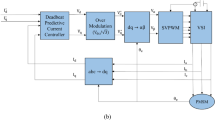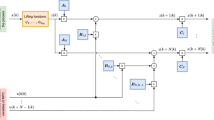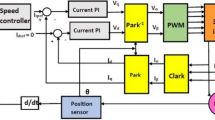Abstract
An adaptive series speed control system for an interior permanent magnet synchronous motor (IPMSM) drive is presented in this paper. This control system consists of a current and a speed control loop, and it is intended to improve the drive’s speed tracking performance as well as to compensate for voltage distortions caused by non-ideal characteristics of the drive’s actuator, which is a voltage source inverter (VSI). To achieve these goals, a simple model that captures these characteristics of the VSI is developed and embedded in the motor’s electrical model. Then, based on the resulting model, an adaptive proportional-integral (PI) control for the current loops is designed, allowing for state regulation and actuator compensation. Additionally, to improve the drive’s speed tracking performance, a proportional-model-reference adaptive controller (MRAC) is designed for the speed loop. Techniques from machine learning are used for designing the MRAC to effectively address nonlinearities and uncertainties in the speed dynamic. Finally, simulation results are presented to illustrate the outstanding performance of the proposed multi-loop controller.













Similar content being viewed by others
References
Hao, Z., Zhang, Q., Fujimoto, K. (2015). Numerical approach for nonlinear optimal control problems based on double generating functions. In: 54th IEEE Conference on Decision and Control (CDC), pp. 3218–3223. Osaka, Japan. https://doi.org/10.1109/CDC.2015.7402702
Ghafari Kashani, A. R., Faiz, J., & Yazdanpanah, M. J. (2010). Integration of non-linear hinf and sliding mode control techniques for motion control of a permanent magnet synchronous motor. IET Electric Power Applications, 4(4), 267–280. https://doi.org/10.1049/iet-epa.2009.0108
Xia, C., Ji, B., & Yan, Y. (2015). Smooth speed control for low-speed high-torque permanent-magnet synchronous motor using proportional integral resonant controller. IEEE Transactions on Industrial Electronics, 62(4), 2123–2134. https://doi.org/10.1109/TIE.2014.2354593
Xu, B., Zhang, L., & Ji, W. (2021). Improved non-singular fast terminal sliding mode control with disturbance observer for pmsm drives. IEEE Transactions on Transportation Electrification, 7(4), 2753–2762. https://doi.org/10.1109/TTE.2021.3083925
Grcar, B., Cafuta, P., Znidaric, M., & Gausch, F. (1996). Nonlinear control of synchronous servo drive. IEEE Transactions on Control Systems Technology, 4(2), 177–184. https://doi.org/10.1109/87.486344
Zhou, C., Quach, D.-C., Xiong, N., Huang, S., Zhang, Q., Yin, Q., & Vasilakos, A. V. (2015). An improved direct adaptive fuzzy controller of an uncertain pmsm for web-based e-service systems. IEEE Transactions on Fuzzy Systems, 23(1), 58–71. https://doi.org/10.1109/TFUZZ.2014.2315675
Azizur Rahman, M., Milasi, R. M., Lucas, C., Araabi, B. N., & Radwan, T. S. (2008). Implementation of emotional controller for interior permanent-magnet synchronous motor drive. IEEE Transactions on Industry Applications, 44(5), 1466–1476. https://doi.org/10.1109/TIA.2008.2002206
Kim, K. H. (2009). Model reference adaptive control-based adaptive current control scheme of a pm synchronous motor with an improved servo performance. IET Electric Power Applications, 3(1), 8–18. https://doi.org/10.1049/iet-epa:20080030
Qi, L., Bao, S., & Shi, H. (2013). Permanent-magnet synchronous motor velocity control based on second-order integral sliding mode control algorithm. Transactions of the Institute of Measurement and Control, 37(7), 875–882. https://doi.org/10.1177/0142331213495886
Li, S., & Liu, Z. (2009). Adaptive speed control for permanent-magnet synchronous motor system with variations of load inertia. IEEE Transactions on Industrial Electronics, 56(8), 3050–3059. https://doi.org/10.1109/TIE.2009.2024655
Qi, L., & Shi, H. (2013). Adaptive position tracking control of permanent magnet synchronous motor based on rbf fast terminal sliding mode control. Neurocomputing, 115, 23–30. https://doi.org/10.1016/j.neucom.2012.11.018
Lin, C. H. (2014). Hybrid recurrent wavelet neural network control of pmsm servo-drive system for electric scooter. International Journal of Control, Automation and Systems, 12(1), 177–187. https://doi.org/10.1007/s12555-012-0190-2
Guo, L., & Parsa, L. (2012). Model reference adaptive control of five-phase ipm motors based on neural network. IEEE Transactions on Industrial Electronics, 59(3), 1500–1508. https://doi.org/10.1109/TIE.2011.2163371
Butt, C. B., & Rahman, M. A. (2013). Untrained artificial neuron-based speed control of interior permanent-magnet motor drives over extended operating speed range. IEEE Transactions on Industry Applications, 49(3), 1146–1153. https://doi.org/10.1109/TIA.2013.2253533
Munoz, A. R., & Lipo, T. A. (1999). On-line dead-time compensation technique for open-loop pwm-vsi drives. IEEE Transactions on Power Electronics, 14(4), 683–689. https://doi.org/10.1109/63.774205
Park, D. M., & Kim, K. H. (2014). Parameter-independent online compensation scheme for dead time and inverter nonlinearity in ipmsm drive through waveform analysis. IEEE Transactions on Industrial Electronincs, 61(2), 701–707. https://doi.org/10.1109/TIE.2013.2251737
Sepe, R. B., & Lang, J. H. (1994). Inverter nonlinearities and discrete-time vector current control. IEEE Transactions on Industrial Applications, 30(1), 62–70. https://doi.org/10.1109/28.273622
Mohamed, Y. A. R. I. (2007). Design and implementation of a robust current-control scheme for a pmsm vector drive with a simple adaptive disturbance observer. IEEE Transactions on Industrial Electronics, 54(4), 1981–1988. https://doi.org/10.1109/TIE.2007.895074
Mohan, N., Undeland, T. M., & Robbins, W. P. (2003). Power Electronics Converters, Applications and Design (3rd ed.). Hoboken: Wiley.
Milasi, R. M., Lynch, A. F., & Li, Y. W. (2013). Adaptive vector control for voltage source converters. Control Theory Applications, IET, 7(8), 1110–1119. https://doi.org/10.1049/iet-cta.2011.0785
Reger, J., Ramírez, H.S., Fliess, M. (2005). On non-asymptotic observation of nonlinear systems. In: Proceedings of the 44th IEEE Conference on Decision and Control, pp. 4219–4224. Seville, Spain. https://doi.org/10.1109/CDC.2005.1582824
Morales, R., Somolinos, J. A., & Sira-Ramírez, H. (2014). Control of a DC motor using algebraic derivative estimation with real time experiments. Measurement, 47, 401–417. https://doi.org/10.1016/j.measurement.2013.09.024
Ioannou, P. A., & Sun, J. (1995). Robust Adaptive Control. Upper Saddle River: Prentice-Hall Inc.
Morimoto, S., Sanada, M., & Takeda, Y. (1994). Effects and compensation of magnetic saturation in flux-weakening controlled permanent magnet synchronous motor drives. IEEE Transactions on Industry Applications, 30(6), 1632. https://doi.org/10.1109/TIA.1994.350318
Morimoto, S., Sanada, M., & Takeda, Y. (1994). Wide-speed operation of interior permanent magnet synchronous motors with high-performance current regulator. IEEE Transactions on Industry Applications, 30(4), 920–926. https://doi.org/10.1109/28.297908
Antonello, R., Carraro, M., & Zigliotto, M. (2014). Maximum-torque-per-ampere operation of anisotropic synchronous permanent-magnet motors based on extremum seeking control. IEEE Transactions on Industrial Electronics, 61(9), 5086–5093. https://doi.org/10.1109/TIE.2013.2278518
Wang, C., Hill, D. J., Ge, S. S., & Chen, G. (2006). An iss-modular approach for adaptive neural control of pure-feedback systems. Automatica, 42(5), 723–731. https://doi.org/10.1016/j.automatica.2006.01.004
Sanner, R. M., & Slotine, J. J. E. (1992). Gaussian networks for direct adaptive control. IEEE Transactions on Neural Networks, 3(6), 837–863. https://doi.org/10.1109/72.165588
Khadraoui, S., Fnaiech, M. A., Nounou, H. N., Nounou, M. N., Guzinski, J., Abu-Rub, H., Datta, A., & Bhattacharyya, S. P. (2016). Measurement-based control approach for tuning pid controllers: application to induction machines. Journal of Control and Decision, 3(3), 179–196. https://doi.org/10.1080/23307706.2016.1153436
Wang, C., Hill, D. J., Ge, S. S., & Chen, G. (2006). An ISS-modular approach for adaptive neural control of pure-feedback systems. Automatica, 42(5), 723–731. https://doi.org/10.1016/j.automatica.2006.01.004
Author information
Authors and Affiliations
Corresponding author
Appendix
Appendix
1.1 Proof of Lemma 1
Following the work [30], we take a Lyapunov approach to prove this lemma. Consider the Lyapunov function candidate
The time derivative of this function along the speed tracking error dynamic (37) is given by
Therefore, we can show that we have
where \(k=k_1-\eta _1/2-\eta _2/2\) for any arbitrary scalars \(\eta _1>0\) and \(\eta _2>0\), and \(\bar{r}>0\) is a lower bound on \(g_\lambda \). It is noted that the inequalities
have been used to arrive at (46). Now, the inequality (46) implies that for
it can be guaranteed that
implying the input-to-state stability of the error dynamic (37) with the input-to-state gain functions as in (39).
Rights and permissions
Springer Nature or its licensor holds exclusive rights to this article under a publishing agreement with the author(s) or other rightsholder(s); author self-archiving of the accepted manuscript version of this article is solely governed by the terms of such publishing agreement and applicable law.
About this article
Cite this article
Lordejani, S.N., Milasi, R.M. An adaptive series control for an interior permanent magnet synchronous motor with actuator compensation. Control Theory Technol. 20, 392–407 (2022). https://doi.org/10.1007/s11768-022-00107-w
Received:
Revised:
Accepted:
Published:
Issue Date:
DOI: https://doi.org/10.1007/s11768-022-00107-w




